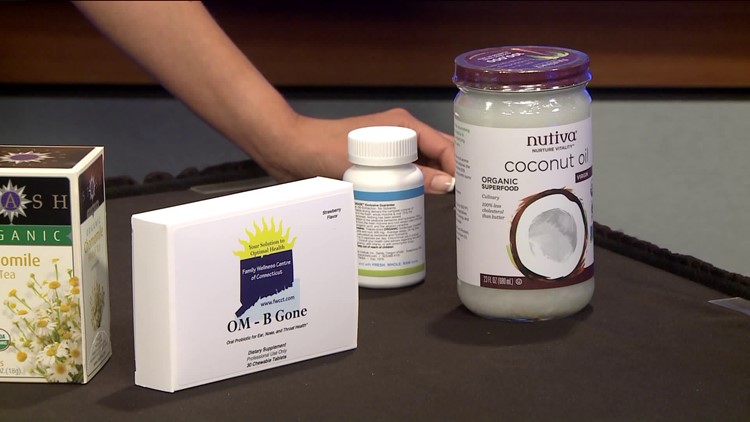HARTFORD – Many parents experience the joy of sending their healthy child off to school only to have them home sick shortly after school begins. Classrooms can be breeding grounds for organisms that cause illnesses in young children, such as:
Head lice
Head lice are a common problem among children attending daycare, and elementary school. This louse is most often spread by direct contact with the hair of an infected person. It is uncommon for head lice to spread by contact with clothing, furniture, or personal items used by an infected person. A diagnosis of head lice should always be confirmed by trained medical personnel, as parents can mistake lint or dandruff for lice. Some natural treatments for head lice include a salt and vinegar mixture to spray on the scalp.
Ringworm
Tinea capitis, also known as ringworm, is an itchy fungal infection of the scalp that can occur at any age. Typically, the impacted areas appear bald, round, scaly, and red or inflamed. A low-grade fever and swollen glands may or may not be present. Ringworm infections are contagious and can spread easily to others by direct contact with an area of ringworm on the body of an infected person, by touching personal items and by pets, particularly cats. Ringworm is effectively treated with home remedies and anti-fungal medications if necessary. Some natural treatments for ringworm include the topical use of apple cider vinegar or tea tree oil.
Hand, foot, and mouth disease (HFMD)
HFMD is an acute viral illness. HFMD typically impacts children younger than five years old, although it can also occur in adults. Signs and symptoms include a skin rash, blister-like sores in an around the mouth and hands and feet, and fever. It is spread from person to person by direct contact, and contaminated surfaces. There is no specific therapy, and children should be out of school until all the blisters are completely gone or scabbed over, which can sometimes take up to ten days. Some natural treatments for HFMD include boosting the immune system with elderberry or vitamin D; soothing the rashes with coconut oil, which is naturally anti-viral; offering warm bone broth and cold coconut water or coconut water popsicles for soothing the mouth; and wet socks help to boost immunity and shorten the duration of the illness.
Strep Infections and Sore Throats
Strep bacteria are the most common causes of sore throats. Although anyone can get strep throat, it is most common in children between the ages of 5-15 years old. Kids may develop sudden symptoms 2-5 days after they come in contact with the nasal secretions or saliva from infected persons. The symptoms may be mild or severe and include sore throat, fever, reddened throat, nausea, and malaise. Currently the AAP recommendation is an antibiotic regime for any positive strep test but the sensitivity with the testing is limited and approximately only 70 percent of valid strep infections are detected. The primary concern for missed strep infections may subsequently cause scarlet fever. Scarlet fever is a disease caused by untreated strep bacteria getting into the blood stream. Symptoms include a rash with a “sandpapery” feel usually appears first on the neck and chest, and then it spreads over the body, lasting for a week or more, Other symptoms include fever, pharyngitis, chills, vomiting, and abdominal pain. A “strawberry tongue,” a tongue with a whitish coating and a red and bumpy appearance, may be present. Also peeling skin in the hands and feet may appear. The major concern with scarlet fever is that if it is left untreated, a small percentage of patients will develop rheumatic fever. Some natural treatments to support the treatment of strep infections include zinc which helps kill bacteria; eliminate most dairy products while the child is ill because they cause congestion and excessive mucus; goldenseal kills strep bacteria; garlic boosts the immune system; gargling apple cider vinegar helps to relieve throat pain; and for children that have constant infections, consider a specific probiotic to reduce the number of infections.
Conjunctivitis
Conjunctivitis is common in children presenting with a red or pink eye. Characteristic signs include red swollen eye balls, mucus drainage, itching and pain. Most cases are self-limited, but pink eye spreads easily in schools and daycare. Some natural treatments for pink eye include topical application of chamomile tea; topical application of breastmilk, which works like a charm; and consider a daily dose of probiotics which can reduce the incidence of reoccurrence. Probiotics have been shown to reduce daycare absences because of fewer colds, and the use of antibiotics.
Fifth disease
Fifth disease is generally a mild, self-limited illness. The initial symptoms are often nonspecific, such as fever, headache, and runny nose. After a few days, most children will develop a “slapped cheek” facial rash, which is the most recognized feature of this disease. Kids usually become ill within 4-14 days after becoming infected. Fifth disease spreads through respiratory contact when an infected person coughs or sneezes. Fifth disease can cause concern in pregnant women, who can develop fetal hydrops and possibly fetal death. It is important to inform pregnant mothers and teachers of the risk from exposure from infected children or teachers should have “titer” levels drawn by blood work to identify if they are immune and not at risk. Fifth disease can also cause an aplastic crisis in patients with sickle cell disease and other blood disorders, these individuals should be identified as well. Some natural treatments for fifth disease include • Echinacea, which has been shown to support the immune system, prevent the frequency of viral infections: Vitamin D; zinc for viral infections, especially colds, absences from school, and antibiotic use in kids; and minimal or no sugar or fake sugar foods which cause the immune system to not work optimally.
Impetigo
Impetigo is an acute, highly contagious staph infection. It is the most common skin infection in children. It tends to affect skin on the face or extremities that has been disrupted by bites, cuts, or abrasions. Some natural treatments include topical coconut oil; topical goldenseal; topical tea tree oil; vitamin C administered orally to help prevent future occurrences and boosting immunity by reducing sugar in the diet which can block the immune system from working properly.
Dr. Kendra Becker-Musante, ND, FNP, BC
www.drkendrabecker.com



